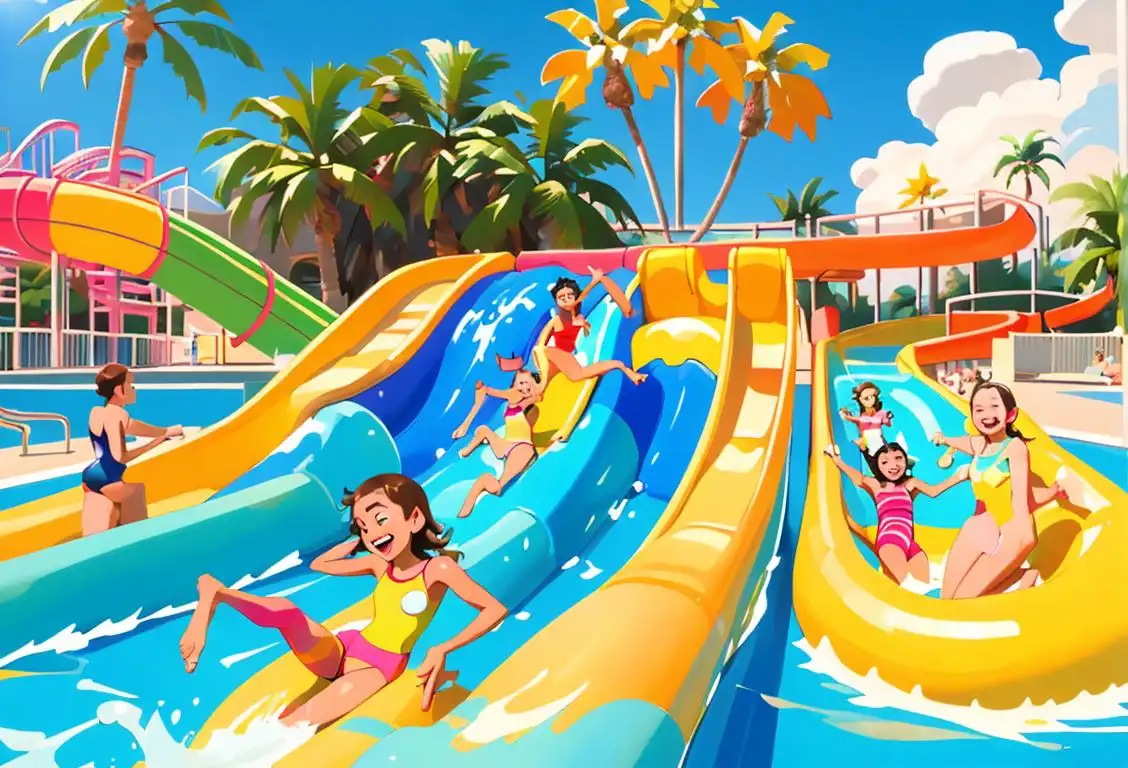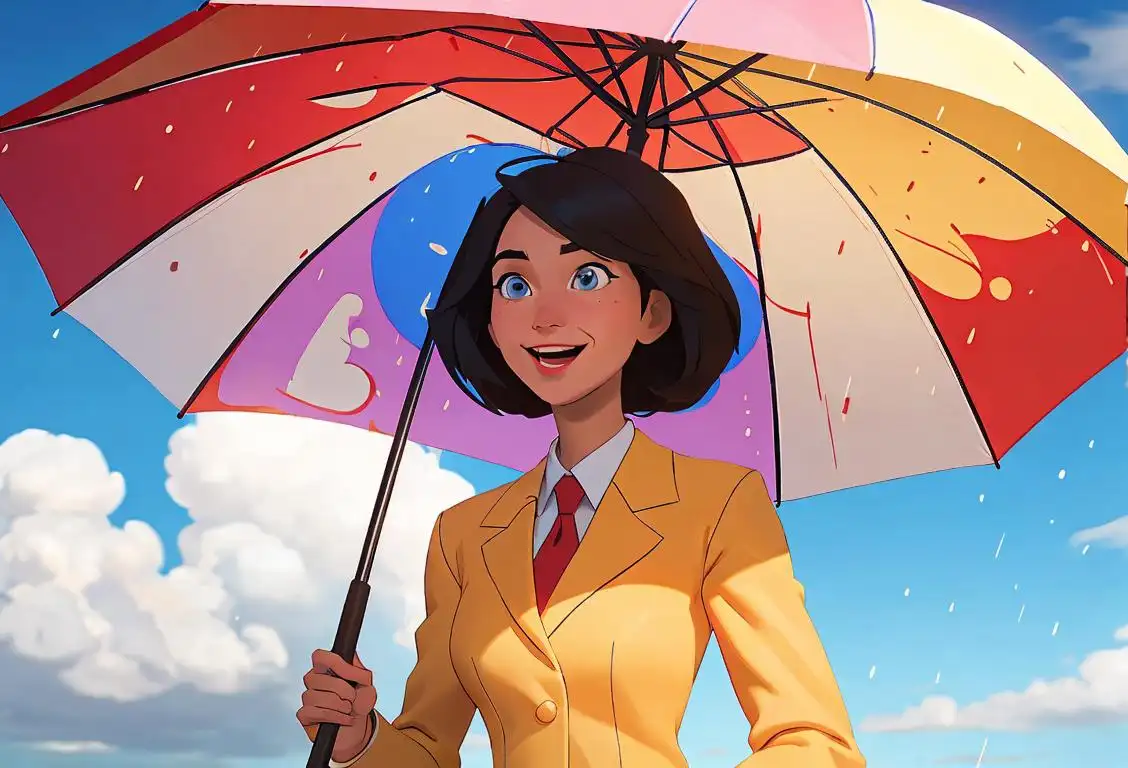National Waterpark Day

Welcome to the splashiest day of the year - National Waterpark Day! Grab your towel, slip on your swimsuit, and get ready for a thrilling adventure at your favorite waterpark. On this special day, we celebrate the wild and wonderful world of water slides, lazy rivers, and wave pools. So, lather up with sunscreen, hold on tight to your rubber duckies, and let's dive into the history of this watery wonderland.
When is Waterpark Day?
It's national waterpark day on the 28th July.
A Soaking Start to National Waterpark Day
Picture this: It's a scorching summer day, and you're desperately trying to find a way to beat the heat. Suddenly, a genius thought pops into your head - what if we create a whole day dedicated to waterparks? And just like that, National Waterpark Day was born!
The origins of this joyful day are as refreshing as a splash from a giant bucket of water. While the exact details are as elusive as a slippery water slide, we do know that people have been seeking aquatic adventures for centuries. From ancient civilizations building early versions of water slides to modern-day waterparks popping up all around the world, people have always found solace and excitement in the cool embrace of crystal-clear pools.
Did you know? The world's tallest water slide is taller than a giraffe standing on top of another giraffe! Known as Verruckt, this towering slide in Kansas City reaches a breathtaking height of 168 feet (51 meters). Better leave that fear of heights at the entrance!
A Splashing Good Time
Waterparks offer something for everyone, from adrenaline junkies seeking white-knuckle thrills to families looking for a day of laughter and relaxation. Whether you're hurling yourself down a dizzying slide, floating gently along a lazy river, or braving the waves in a wave pool, there's no doubt that you'll make memories that last a lifetime.
Nowadays, waterparks are much more than just a collection of slides and pools. Many parks feature imaginative themes, like tropical islands, ancient civilizations, and even outer space! You can find towering water coasters, heart-stopping drop slides, and interactive play areas that will delight even the littlest water adventurers. Remember to bring your sense of wonder and maybe even a waterproof camera to capture all the watery wonders.
Making a Splash Online
Now, let's talk about the internet's role in celebrating National Waterpark Day. With the rise of social media, waterpark enthusiasts from around the world come together to share their favorite slides, tips for beating the lines, and epic wipeout videos. Whether via hashtags, photo contests, or online reviews, the internet has become a digital playground for waterpark aficionados. So, if you're not able to visit a waterpark in person, grab your virtual inner tube and take a virtual slide down the information superhighway to discover all the wonders of waterparks online!
History behind the term 'Waterpark'
1970
Invention of the FlowRider
In 1970, a surf enthusiast named Thomas J. Lochtefeld invented the first artificial wave machine, which he called the FlowRider. This machine propelled a thin sheet of water up a inclined surface, simulating the feeling of riding a real wave. The invention of the FlowRider laid the foundation for the development of modern waterparks.
1940
The Birth of the Modern Water Slide
In the year 1940, the first modern water slide was created by Herbert Sellner, an engineer and inventor from Minnesota. Sellner patented his design for a water slide and named it the 'Water-Toboggan Slide.' This early water slide consisted of a long, narrow wooden chute with water flowing down it, providing a thrilling and refreshing experience for riders.
1949
First Outdoor Water Park
The concept of a waterpark was first popularized in 1949 with the construction of Wet'n Wild in Orlando, Florida. Wet'n Wild featured various water attractions like slides, a wave pool, and lazy river. This pioneering park set the stage for the future of water-based entertainment.
1970
The Introduction of Wave Pools
In the year 1970, the concept of wave pools was introduced to water parks. Wave pools simulate the experience of ocean waves, allowing visitors to enjoy swimming in the pool while experiencing the ebb and flow of the waves. The introduction of wave pools added a new level of excitement and entertainment to water parks, attracting larger crowds and setting the stage for the development of more elaborate water attractions.
1977
Opening of Wet 'n Wild
In 1977, the first modern waterpark, Wet 'n Wild, opened its doors in Orlando, Florida. Founded by George Millay, Wet 'n Wild featured a variety of thrilling water attractions, including slides, wave pools, and lazy rivers. This marked the beginning of the waterpark industry's exponential growth worldwide.
1977
Introduction of Indoor Water Parks
The year 1977 marked a significant turning point for waterparks with the opening of the first indoor water park called World Waterpark in Edmonton, Canada. This innovation allowed water enthusiasts to enjoy water-based activities and attractions year-round, regardless of weather conditions.
1984
Introduction of Two-Person Rafts
In 1984, the waterpark industry introduced two-person rafts, allowing visitors to enjoy water slides together. This innovation not only increased the social aspect of waterpark experiences but also enhanced the excitement and thrill of sliding down winding and twisting slides.
1977
The Birth of the First Modern Waterpark
The year 1977 marked the birth of the first modern waterpark, named Wet 'n Wild. Located in Orlando, Florida, Wet 'n Wild was founded by George Millay, a pioneer in the water park industry. This waterpark featured a variety of water slides, wave pools, lazy rivers, and other water-based attractions all within a single park. Wet 'n Wild set the template for future waterparks and became a popular destination for families seeking water-based fun and thrills.
1985
The Birth of 'Waterpark' Term
In 1985, the term 'waterpark' gained widespread recognition as a specific genre of amusement park. It was coined to describe the unique attractions and experiences offered by these water-based entertainment venues. 'Waterpark' became the official and widely used term to refer to parks solely dedicated to aquatic fun.
1990
Emergence of Mega Water Parks
The 1990s witnessed the emergence of large-scale water parks known as mega water parks. These complexes, featuring extensive water attractions, expanded rapidly and soon became popular vacation destinations. Notable examples include Schlitterbahn Waterpark Resort in Texas and Noah's Ark Waterpark in Wisconsin.
2000
Advancements in Water Slide Technology
By the year 2000, advancements in water slide technology had transformed the industry. Water slides became more intricate, featuring elaborate twists, turns, and drops, while offering different levels of thrills for riders. Innovations like uphill water coasters and funnel slides were introduced, taking the waterpark experience to new heights. These advancements pushed the boundaries of engineering and provided visitors with exhilarating and unforgettable experiences.
1990
Expansion of Waterpark Chains
During the 1990s, several waterpark chains expanded across the United States. Waterpark giants such as Six Flags, Great Wolf Lodge, and Schlitterbahn established multiple locations nationwide, making waterparks more accessible to people across the country. This led to a surge in popularity and attendance at waterparks.
2000
Innovation and Theme Integration
As the new millennium dawned, water parks continued to evolve, embracing innovation and integration of themes. Parks like Disney's Typhoon Lagoon and Blizzard Beach in Florida combined water-based attractions with immersive narratives, further enhancing the visitor experience.
2000
Advancements in Water Slide Technology
In the early 2000s, advancements in water slide technology revolutionized the waterpark industry. Manufacturers began using computer-aided design (CAD) and engineering to create more intricate and thrilling slides. This resulted in the development of complex slide structures, including loops, funnel slides, and speed slides, offering visitors breathtaking and adrenaline-pumping experiences.
2014
Invention of the Water Coaster
In 2014, ProSlide Technology introduced the world's first water coaster, a hybrid water slide that combines roller coaster elements with water. The water coaster allows riders to experience gravity-defying drops, twists, and turns while being propelled by high-pressure water jets. This innovation further elevated the excitement level and added a new dimension to waterpark attractions.
Present
The Evolution of Waterpark Experiences
Today, waterparks continue to evolve and offer a wide array of thrilling and family-friendly attractions. From multi-lane racing slides to colossal wave pools and extravagant water play structures, waterparks have become destinations that provide unforgettable experiences for individuals of all ages. They have also become a significant part of the tourism industry, attracting millions of visitors each year.
Did you know?
The world's tallest water slide is taller than a giraffe standing on top of another giraffe!Tagged
romance nsfw funFirst identified
28th July 2017Most mentioned on
28th July 2018Total mentions
434Other days
Aldub Day
Weatherpersons Day
Love Pizza Day
Kisses Day
Awareness Day
One Day
Children Day
Happiness Day
Opposite Day
Ojd Day









